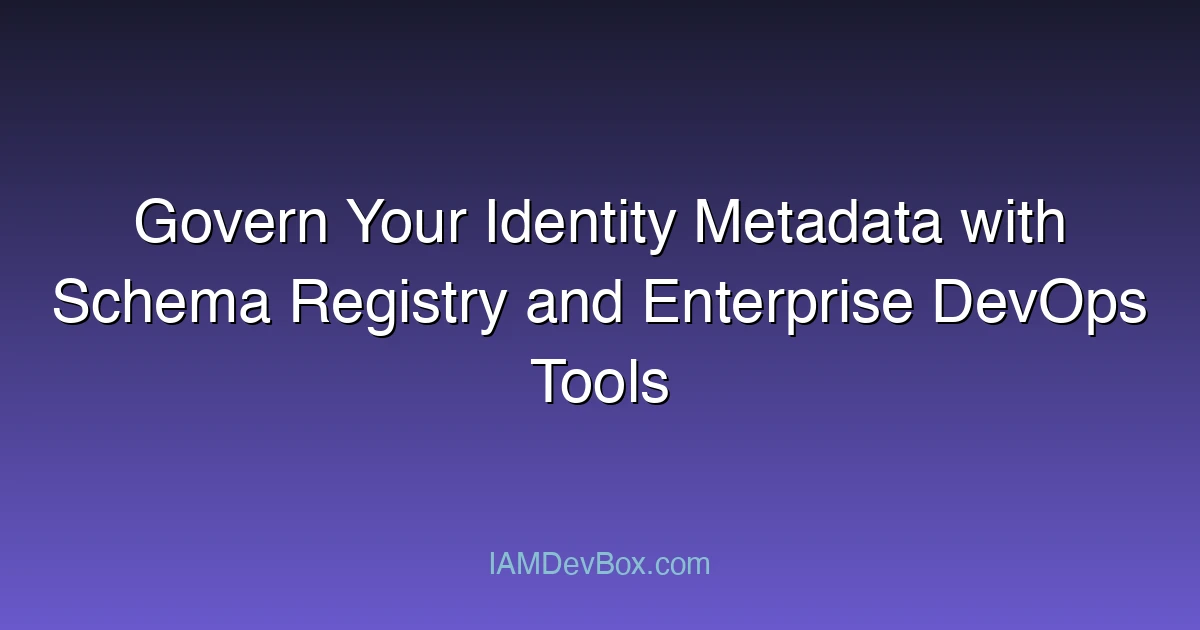Visual Overview:
graph TB
subgraph "Microservices Authentication"
Client[Client] --> Gateway[API Gateway]
Gateway --> Auth[Auth Service]
Auth --> TokenStore[(Token Store)]
Gateway --> ServiceA[Service A]
Gateway --> ServiceB[Service B]
Gateway --> ServiceC[Service C]
ServiceA --> ServiceB
ServiceB --> ServiceC
end
style Gateway fill:#667eea,color:#fff
style Auth fill:#764ba2,color:#fff
In large organizations managing complex identity systems with ForgeRock IDM and LDAP, uncontrolled schema evolution and inconsistent mappings can lead to serious issues—data drift, broken syncs, and compliance failures. How do you ensure schema consistency across environments? The answer lies in building an internal Schema Registry and using enterprise-ready CI/CD tools like Jenkins to automate governance.
🔍 Why Enterprises Need a Schema Registry
A schema registry serves as a centralized, version-controlled source of truth for:
- LDAP object classes and attributes
- IDM managed object properties and mappings
- Data transformation logic
- Attribute deprecation and migration rules
It allows identity teams to:
- Synchronize schema across dev, staging, and production
- Detect unauthorized changes or mismatches
- Track changes over time for auditability
- Automate mapping regeneration and data validation
In essence, the registry brings GitOps to identity metadata.
🛠️ Building an Internal Schema Registry with YAML or JSON
Start simple using enterprise-approved formats like YAML:
schemaVersion: 1.0.2
objectClass: inetOrgPerson
attributes:
- name: cn
type: string
required: true
- name: mail
type: string
format: email
- name: employeeId
type: string
deprecated: false
A parallel file defines the mapping logic for ForgeRock IDM:
idmMappings:
- source: mail
target: email
transform: identity
- source: employeeId
target: employeeNumber
transform: stringToInt
Store these definitions in your enterprise Git server (e.g., Bitbucket, GitLab, GitHub Enterprise) and enforce change control via internal merge request policies.
🏗️ Integrating Schema Validation into Jenkins Pipelines
Most enterprises use Jenkins as the central DevOps engine. Here’s how to automate schema governance in your Jenkins pipeline:
pipeline {
agent any
stages {
stage('Checkout Schema Repo') {
steps {
git url: 'https://git.company.com/identity/schema.git'
}
}
stage('Validate YAML Schema') {
steps {
sh 'yamllint ./schemas/'
sh 'python validate_schema.py ./schemas/ --rules ruleset.yaml'
}
}
stage('Test IDM Mappings') {
steps {
sh './test-idm-mapping.sh'
}
}
stage('Generate Mapping Files') {
steps {
sh 'python generate_mapping.py --input schemas/ --output idm/conf/mapping.json'
archiveArtifacts artifacts: 'idm/conf/mapping.json'
}
}
}
}
🔒 Bonus: Trigger a downstream deployment to a ForgeRock IDM sandbox for live validation.
🔄 Change Management with Git + Jenkins
Combine Git and Jenkins for a solid metadata governance workflow:
- Developer proposes schema change in a feature branch
- Jenkins CI job validates syntax, backward compatibility, and field coverage
- Pull request triggers peer review and compliance approval
- Jenkins merges and triggers mapping regeneration
- Artifacts are version-tagged and deployed to IDM environments
This aligns identity infrastructure with your enterprise’s broader DevSecOps practices.
📊 Use Cases: Real-World Benefits
- A global financial institution standardized 7 identity schemas across 15 applications
- Jenkins auto-generated over 120 mapping files during CI runs, eliminating manual sync errors
- Audit teams could trace every schema attribute change across 3 years of commits
- Developers reduced schema-related bugs by 80% post-implementation
🚀 Best Practices for Enterprise Adoption
- ✅ Use Jenkins shared libraries for schema validation logic
- 📦 Package the registry and mapping generator into internal Python or Java microservices
- 🧪 Run LDIF-based test simulations post-deployment (via ForgeRock IDM REST)
- 📝 Document schema changes in Confluence or an internal metadata portal
Optional: Integrate with Jira Service Desk for schema change requests and approval workflows.
🧠 Food for Thought
If not, now is the time to bring identity metadata into your CI/CD pipeline.
